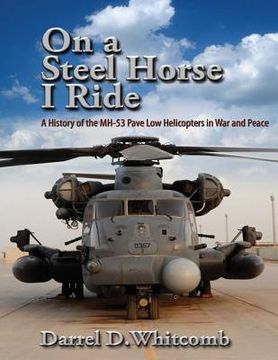On a Steel Horse I Ride: A History of the MH-53 Pave Low Helicopters in War and Peace (en Inglés)
Reseña del libro "On a Steel Horse I Ride: A History of the MH-53 Pave Low Helicopters in War and Peace (en Inglés)"
Pave Low. The term itself generates an image: a dark, wispy night; a low, pulsating rumble approaching from the distance. The rumble becomes a presence, a large helicopter that settles onto the ground amidst the deep darkness. Earnest men of determination spew forth from it. Heavily armed, they quickly set up to collect intelligence, kill enemy troops, rescue downed or isolated friendly personnel, or otherwise conduct a direct action mission. Mission complete, they just as quickly reassemble, reboard the aircraft, and then disappear into the consuming darkness. It is a powerful image-a conjure, if you will-that strikes fear into any enemy of the United States. But the conjure is real. It is a helicopter called the MH-53J/M. That machine is the end result of the evolution of state-of-the-art avionics, communication, and navigation equipment crewed by highly motivated, enthusiastic, and smart young operators well steeped in the principles, heritage, and credo of special operations. It is the classic combination of men and machine. Those aircraft and Airmen were assigned to the US Air Force Special Operations Command (AFSOC), "America's specialized airpower . . . a step ahead in a changing world, delivering special operations power anytime, anywhere."1 AFSOC controls a mixed fleet of both rotaryand fixed-wing aircraft to facilitate the fulfillment of that mission. However, the single aircraft that, in its day, has best epitomized that role is the Pave Low helicopter. It, perhaps more than any other aircraft, allowed the AFSOC to realize its purpose. But it was not always so. The aircraft themselves were revolutionary combinations of new, more powerful turbine engines with rotarywing aircraft to produce vastly increased lifting power. Conceptualized, built, and designated for simpler missions, they were immediately swept up into the long war in Southeast Asia. There they proved the efficacy of the aircraft for dangerous rescue missions, for the initiation of a whole new generation of developing avionics and navigation technology, for providing challenging direct support to small special forces teams and indigenous forces inserted behind enemy lines, and for a myriad of other things that heavy-lift helicopters could be assigned to do. In accomplishing all of that, they also trained a whole generation of men who learned of combat along the Ho Chi Minh Trail in Laos and at other places like Quang Tri, South Vietnam; Son Tay, North Vietnam; and Koh Tang Island, Cambodia. After that conflict, those aircraft and men were returned to peacetime locations and duties, and much was forgotten of those dangerous times and missions. However, a cadre of dedicated combat aviators and commanders felt that the aircraft and community of Airmen had much more to give. Foreseeing an ever-dangerous world, they harnessed those aircraft to a series of evolving new technologies that vastly improved the aircraft by giving them the ability to traverse airspace in any weather conditions, day and night, and to avoid enemy threats. That concept was validated in operations in Panama, Kuwait, Iraq, Serbia, Afghanistan, and many more smaller and quieter operations in between. The men and aircraft also showed the larger utilitarian value of the aircraft as, over the years, they were called out many times to provide natural disaster and humanitarian relief from Africa to New Orleans, Louisiana.

